
Rosatom: an integrated approach to preserving the legacy of the nuclear industry
 |
Rosatom, Russia’s largest company operating in the nuclear energy market, takes very seriously the preservation of the tremendous cultural and historical legacy that the country has accumulated throughout the 65-years that it has been implementing the “Soviet Nuclear Project”.
“At present, the issue of the foundation of a National Museum of Power Engineering is being considered at the level of the federal government. An important element of it
|
would be an exhibition devoted to nuclear power engineering and industry”, Sergey Novikov, Director of Communications Department at Rosatom, said recently.
The National Museum of Power Engineering is to be located within the All-Russian Exhibition Center (former Exhibition of People’s Economic Achievements, the largest exhibition complex during the Soviet era, which is situated north-east of Moscow).
The Museum’s exhibition will be hosted in a specially designed and constructed building that will cover a surface area of about 9,000 m2. “We want the museum’s concept to include advanced technologies and be as interactive and understandable as possible for a wide range of visitors - from pre-school children to elderly citizens”, says Nikolai Doronin, Rosatom’s Museum Programme Coordinator. “In creating the concept, we are interested in using the experience and capabilities on offer from specialised programmes developed by international companies. If they find the proposal interesting, they would be given an opportunity to tender for the concept and provide an architectural model for the museum, which is to be announced in the first quarter of 2012”, according to Mr. Doronin. The Power Engineering Museum will be positioned as a centre for cognitive leisure-time activity for the whole family and follow an “edutainment” format.
In addition, Rosatom is also planning activities aimed at preserving and developing the historical legacy of the industry, which is a valuable global asset. First of all, a list of such historical products and facilities includes the Lenin, the world’s first nuclear icebreaker, and the first nuclear power plant, which was built in the town of Obninsk, in the Moscow Region.
“We believe that nowadays both these “facilities” symbolise not so much the industrial power of the Soviet empire, but rather unique facilities that are part of our global engineering heritage”, says Sergey Novikov. “Therefore, rather than developing them on our own, we would prefer to invite as many interested parties as possible to discuss the future of the concept. First of all, I refer to our European colleagues. For these purposes, we are planning to hold a large-scale conference this year and to invite potential partners and donors to participate”.
It is worth noting that the icebreaker Lenin, which is moored in the municipal port of Murmansk, hosts a Rosatom information center and a permanent Kola Atom exhibition set up in partnership with the TASIS Program. Within the next 20 years, the Obninskaya nuclear power plant will be classified as a “radioactively hazardous facility”, according to international legislation. However, today it features a temporary exhibition and in 2012, Rosatom plans to create - in an Obninsk museum - a permanent and comprehensive exhibition space devoted to the history of the plant and how it developed over the years.
In the short term, a non-commercial foundation will be set up as the administrator of all Russian museums devoted to nuclear industry. Initially, Rosatom will be its largest donator. However, in the future the foundation will raise non-sectoral funds from partner organisations and donors to museum projects in the Russian nuclear industry, including international companies.
|

